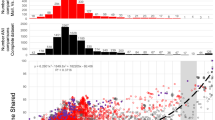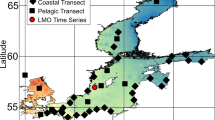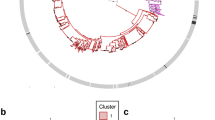Abstract
Metagenomic surveys have revealed that natural microbial communities are predominantly composed of sequence-discrete, species-like populations but the genetic and/or ecological processes that maintain such populations remain speculative, limiting our understanding of population speciation and adaptation to perturbations. To address this knowledge gap, we sequenced 112 Salinibacter ruber isolates and 12 companion metagenomes from four adjacent saltern ponds in Mallorca, Spain that were experimentally manipulated to dramatically alter salinity and light intensity, the two major drivers of this ecosystem. Our analyses showed that the pangenome of the local Sal. ruber population is open and similar in size (~15,000 genes) to that of randomly sampled Escherichia coli genomes. While most of the accessory (noncore) genes were isolate-specific and showed low in situ abundances based on the metagenomes compared to the core genes, indicating that they were functionally unimportant and/or transient, 3.5% of them became abundant when salinity (but not light) conditions changed and encoded for functions related to osmoregulation. Nonetheless, the ecological advantage of these genes, while significant, was apparently not strong enough to purge diversity within the population. Collectively, our results provide an explanation for how this immense intrapopulation gene diversity is maintained, which has implications for the prokaryotic species concept.
Similar content being viewed by others
Log in or create a free account to read this content
Gain free access to this article, as well as selected content from this journal and more on nature.com
or
Data availability
The data for this study has been deposited in the European Nucleotide Archive (ENA) at EMBL-EBI under accession number PRJEB27680.
Code availability
The custom code for these analyses are available on GitHub: https://github.com/rotheconrad/Salinibacter_ruber_01.
References
Kislyuk AO, Haegeman B, Bergman NH, Weitz JS. Genomic fluidity: an integrative view of gene diversity within microbial populations. BMC Genom. 2011;12:1–10.
Tettelin H, Riley D, Cattuto C, Medini D. Comparative genomics: the bacterial pan-genome. Curr Opin Microbiol. 2008;11:472–7.
Tettelin H, Masignani V, Cieslewicz MJ, Donati C, Medini D, Ward NL, et al. Genome analysis of multiple pathogenic isolates of Streptococcus agalactiae: implications for the microbial “pan-genome”. Proc Natl Acad Sci USA. 2005;102:13950–5.
Medini D, Donati C, Tettelin H, Masignani V, Rappuoli R. The microbial pan-genome. Curr Opin Genet Dev. 2005;15:589–94.
Vernikos G, Medini D, Riley DR, Tettelin H. Ten years of pan-genome analyses. Curr Opin Microbiol. 2015;23:148–54.
Caro-Quintero A, Konstantinidis KT. Bacterial species may exist, metagenomics reveal. Environ Microbiol. 2012;14:347–55.
Garcia SL, Stevens SLR, Crary B, Martinez-Garcia M, Stepanauskas R, Woyke T, et al. Contrasting patterns of genome-level diversity across distinct co-occurring bacterial populations. ISME J. 2018;12:742–55.
Olm MR, Crits-Christoph A, Diamond S, Lavy A, Matheus Carnevali PB, Banfield JF. Consistent metagenome-derived metrics verify and delineate bacterial species boundaries. mSystems. 2020;5:e00731–19.
Konstantinidis KT, DeLong EF. Genomic patterns of recombination, clonal divergence and environment in marine microbial populations. ISME J. 2008;2:1052–65.
Bendall ML, Stevens SL, Chan LK, Malfatti S, Schwientek P, Tremblay J, et al. Genome-wide selective sweeps and gene-specific sweeps in natural bacterial populations. ISME J. 2016;10:1589–601.
Johnston ER, Rodriguez RL, Luo C, Yuan MM, Wu L, He Z, et al. Metagenomics reveals pervasive bacterial populations and reduced community diversity across the Alaska tundra ecosystem. Front Microbiol. 2016;7:579.
Meziti A, Tsementzi D, Rodriguez RL, Hatt JK, Karayanni H, Kormas KA, et al. Quantifying the changes in genetic diversity within sequence-discrete bacterial populations across a spatial and temporal riverine gradient. ISME J. 2019;13:767–79.
Orellana LH, Ben Francis T, Kruger K, Teeling H, Muller MC, Fuchs BM, et al. Niche differentiation among annually recurrent coastal Marine Group II Euryarchaeota. ISME J. 2019;13:3024–36.
Jain C, Rodriguez RL, Phillippy AM, Konstantinidis KT, Aluru S. High throughput ANI analysis of 90K prokaryotic genomes reveals clear species boundaries. Nat Commun. 2018;9:5114.
Shapiro BJ, Polz MF. Ordering microbial diversity into ecologically and genetically cohesive units. Trends Microbiol. 2014;22:235–47.
Andreani NA, Hesse E, Vos M. Prokaryote genome fluidity is dependent on effective population size. ISME J. 2017;11:1719–21.
Konstantinidis KT, Ramette A, Tiedje JM. The bacterial species definition in the genomic era. Philos Trans R Soc B 2006;361:1929–40.
McInerney JO, McNally A, O’Connell MJ. Why prokaryotes have pangenomes. Nat Microbiol. 2017;2:17040.
Bowers RM, Kyrpides NC, Stepanauskas R, Harmon-Smith M, Doud D, Reddy TBK, et al. Minimum information about a single amplified genome (MISAG) and a metagenome-assembled genome (MIMAG) of bacteria and archaea. Nat Biotechnol. 2017;35:725–31.
Tully BJ, Graham ED, Heidelberg JF. The reconstruction of 2,631 draft metagenome-assembled genomes from the global oceans. Sci Data. 2018;5:170203.
Chen LX, Anantharaman K, Shaiber A, Eren AM, Banfield JF. Accurate and complete genomes from metagenomes. Genome Res. 2020;30:315–33.
Shaiber A, Eren AM. Composite metagenome-assembled genomes reduce the quality of public genome repositories. mBio. 2019;10:e00725–19.
Hug LA, Baker BJ, Anantharaman K, Brown CT, Probst AJ, Castelle CJ, et al. A new view of the tree of life. Nat Microbiol. 2016;1:16048.
Meziti A, Rodriguez-R LM, Hatt JK, Peña-Gonzalez A, Levy K, Konstantinidis KT. The reliability of metagenome-assembled genomes (MAGs) in representing natural populations: Insights from comparing MAGs against isolate genomes derived from the same fecal sample. Appl Environ Microbiol. 2021;87:e02593–20.
Meziti A, Tsementzi D, Ar Kormas K, Karayanni H, Konstantinidis KT. Anthropogenic effects on bacterial diversity and function along a river-to-estuary gradient in Northwest Greece revealed by metagenomics. Environ Microbiol. 2016;18:4640–52.
Arevalo P, VanInsberghe D, Elsherbini J, Gore J, Polz MF. A reverse ecology approach based on a biological definition of microbial populations. Cell. 2019;178:820–34.e14.
Delmont TO, Eren AM. Linking pangenomes and metagenomes: the Prochlorococcus metapangenome. PeerJ. 2018;6:e4320.
Delmont TO, Kiefl E, Kilinc O, Esen OC, Uysal I, Rappe MS, et al. Single-amino acid variants reveal evolutionary processes that shape the biogeography of a global SAR11 subclade. Elife. 2019;8:e46497.
Berube PM, Biller SJ, Hackl T, Hogle SL, Satinsky BM, Becker JW, et al. Single cell genomes of Prochlorococcus, Synechococcus, and sympatric microbes from diverse marine environments. Sci Data. 2018;5:1–11.
Kashtan N, Roggensack SE, Rodrigue S, Thompson JW, Biller SJ, Coe A, et al. Single-cell genomics reveals hundreds of coexisting subpopulations in wild Prochlorococcus. Science. 2014;344:416–20.
Viver T, Orellana LH, Diaz S, Urdiain M, Ramos-Barbero MD, Gonzalez-Pastor JE, et al. Predominance of deterministic microbial community dynamics in salterns exposed to different light intensities. Environ Microbiol. 2019;21:4300–15.
Viver T, Cifuentes A, Diaz S, Rodriguez-Valdecantos G, Gonzalez B, Anton J, et al. Diversity of extremely halophilic cultivable prokaryotes in Mediterranean, Atlantic and Pacific solar salterns: evidence that unexplored sites constitute sources of cultivable novelty. Syst Appl Microbiol. 2015;38:266–75.
Viver T, Conrad RE, Orellana LH, Urdiain M, González-Pastor JE, Hatt JK, et al. Distinct ecotypes within a natural haloarchaeal population enable adaptation to changing environmental conditions without causing population sweeps. ISME J. 2020:15:1–14.
Konstantinidis KT, Tiedje JM. Trends between gene content and genome size in prokaryotic species with larger genomes. Proc Natl Acad Sci USA. 2004;101:3160–5.
Rodriguez‐R LM, Tsementzi D, Luo C, Konstantinidis KT. Iterative subtractive binning of freshwater chronoseries metagenomes identifies over 400 novel species and their ecologic preferences. Environ Microbiol. 2020;22:3394–412.
Pena A, Teeling H, Huerta-Cepas J, Santos F, Yarza P, Brito-Echeverria J, et al. Fine-scale evolution: genomic, phenotypic and ecological differentiation in two coexisting Salinibacter ruber strains. ISME J. 2010;4:882–95.
Maistrenko OM, Mende DR, Luetge M, Hildebrand F, Schmidt TSB, Li SS, et al. Disentangling the impact of environmental and phylogenetic constraints on prokaryotic within-species diversity. ISME J. 2020;14:1247–59.
Anton J, Lucio M, Pena A, Cifuentes A, Brito-Echeverria J, Moritz F, et al. High metabolomic microdiversity within co-occurring isolates of the extremely halophilic bacterium Salinibacter ruber. PLOS ONE. 2013;8:e64701.
Luley-Goedl C, Nidetzky B. Glycosides as compatible solutes: biosynthesis and applications. Nat Prod Rep. 2011;28:875–96.
Antón J, Oren A, Benlloch S, Rodríguez-Valera F, Amann R, Rosselló-Mora R. Salinibacter ruber gen. nov., sp. nov., a novel, extremely halophilic member of the bacteria from saltern crystallizer ponds. IJSEM. 2002;52:485–91.
Antón J, Rosselló-Mora R, Rodríguez-Valera F, Amann R. Extremely halophilic bacteria in crystallizer ponds from solar salterns. Appl Environ Microbiol. 2000;66:3052–7.
Viver T, Orellana L, Gonzalez-Torres P, Diaz S, Urdiain M, Farias ME, et al. Genomic comparison between members of the Salinibacteraceae family, and description of a new species of Salinibacter (Salinibacter altiplanensis sp. nov.) isolated from high altitude hypersaline environments of the Argentinian Altiplano. Syst Appl Microbiol. 2018;41:198–212.
Oren A, Rodríguez-Valera F. The contribution of halophilic Bacteria to the red coloration of saltern crystallizer ponds. FEMS Microbiol Ecol. 2001;36:123–30.
Santos F, Moreno-Paz M, Meseguer I, Lopez C, Rossello-Mora R, Parro V, et al. Metatranscriptomic analysis of extremely halophilic viral communities. ISME J. 2011;5:1621–33.
Kuo CH, Ochman H. Deletional bias across the three domains of life. Genome Biol Evol. 2009;1:145–52.
Lane N, Martin W. The energetics of genome complexity. Nature. 2010;467:929–34.
Vos M, Hesselman MC, Te Beek TA, van Passel MWJ, Eyre-Walker A. Rates of lateral gene transfer in prokaryotes: high but why? Trends Microbiol. 2015;23:598–605.
Gogarten JP, Townsend JP. Horizontal gene transfer, genome innovation and evolution. Nat Rev Microbiol. 2005;3:679–87.
Sczyrba A, Hofmann P, Belmann P, Koslicki D, Janssen S, Droge J, et al. Critical Assessment of Metagenome Interpretation-a benchmark of metagenomics software. Nat Methods. 2017;14:1063–71.
Munoz R, Lopez-Lopez A, Urdiain M, Moore ER, Rossello-Mora R. Evaluation of matrix-assisted laser desorption ionization-time of flight whole cell profiles for assessing the cultivable diversity of aerobic and moderately halophilic prokaryotes thriving in solar saltern sediments. Syst Appl Microbiol. 2011;34:69–75.
Urdiain M, López-López A, Gonzalo C, Busse H-J, Langer S, Kämpfer P, et al. Reclassification of Rhodobium marinum and Rhodobium pfennigii as Afifella marina gen. nov. comb. nov. and Afifella pfennigii comb. nov., a new genus of photoheterotrophic Alphaproteobacteria and emended descriptions of Rhodobium, Rhodobium orientis and Rhodobium gokarnense. Syst Appl Microbiol. 2008;31:339–51.
Andrews S. FastQC: a quality control tool for high throughput sequence data. Cambridge, United Kingdom: Babraham Bioinformatics, Babraham Institute; 2010.
Bolger AM, Lohse M, Usadel B. Trimmomatic: a flexible trimmer for Illumina sequence data. Bioinformatics. 2014;30:2114–20.
Hyatt D, Chen G-L, LoCascio PF, Land ML, Larimer FW, Hauser LJ. Prodigal: prokaryotic gene recognition and translation initiation site identification. BMC Bioinform. 2010;11:119.
Rodriguez-R LM, Gunturu S, Harvey WT, Rosselló-Mora R, Tiedje JM, Cole JR, et al. The Microbial Genomes Atlas (MiGA) webserver: taxonomic and gene diversity analysis of Archaea and Bacteria at the whole genome level. Nucleic Acids Res. 2018;46:W282–8.
Sievers F, Wilm A, Dineen D, Gibson TJ, Karplus K, Li W, et al. Fast, scalable generation of high‐quality protein multiple sequence alignments using Clustal Omega. Mol Syst Biol. 2011;7:539.
Stamatakis A. RAxML version 8: a tool for phylogenetic analysis and post-analysis of large phylogenies. Bioinformatics. 2014;30:1312–3.
Price MN, Dehal PS, Arkin AP. FastTree 2–approximately maximum-likelihood trees for large alignments. PLOS ONE. 2010;5:e9490.
Rambaut A. FigTree v1.4.4. http://tree.bio.ed.ac.uk/software/figtree/ 2018.
Letunic I, Bork P. Interactive Tree Of Life (iTOL): an online tool for phylogenetic tree display and annotation. Bioinformatics. 2007;23:127–8.
Fu L, Niu B, Zhu Z, Wu S, Li W. CD-HIT: accelerated for clustering the next-generation sequencing data. Bioinformatics. 2012;28:3150–2.
Camacho C, Coulouris G, Avagyan V, Ma N, Papadopoulos J, Bealer K, et al. BLAST+: architecture and applications. BMC Bioinform. 2009;10:421.
Aramaki T, Blanc-Mathieu R, Endo H, Ohkubo K, Kanehisa M, Goto S, et al. KofamKOALA: KEGG ortholog assignment based on profile HMM and adaptive score threshold. Bioinformatics. 2020;36:2251–2.
Kanehisa M, Goto S. KEGG: kyoto encyclopedia of genes and genomes. Nucleic Acids Res. 2000;28:27–30.
Acknowledgements
The authors would particularly like to thank the whole team at Salinas d’Es Trenc and Gusto Mundial Balearides, S.L. (Flor de Sal d´Es Trenc) for allowing access to their facilities and for their support in performing the experiments. This work was partly funded by the US National Science Foundation, awards #1831582 and #1759831 (to KTK), and by the projects CLG2015_66686-C3-1-P, PGC2018-096956-B-C41, and RTC-2017-6405-1 of the Spanish Ministry of Science, Innovation and Universities (to RRM), which were also supported with European Regional Development Fund (FEDER) funds. RRM acknowledges the financial support of the sabbatical stay at Georgia Tech by the grant PRX18/00048 also from the Spanish Ministry of Science, Innovation and Universities. We thank Miguel Rodriguez-R and Carlos Ruiz for useful discussions on the methodology applied and ecologic implications of our results as well as the Partnership for an Advanced Computing Environment (PACE) at the Georgia Institute of Technology, which enabled the computational tasks associated with this study.
Author information
Authors and Affiliations
Contributions
RRM and KTK designed the study and evaluated results; REC analyzed data and wrote the first draft of the paper; TV, JFG, JKH, and SNV contributed data and/or suggestions about data analysis; all authors reviewed the paper and approved it.
Corresponding authors
Ethics declarations
Competing interests
The authors declare no competing interests.
Additional information
Publisher’s note Springer Nature remains neutral with regard to jurisdictional claims in published maps and institutional affiliations.
Rights and permissions
About this article
Cite this article
Conrad, R.E., Viver, T., Gago, J.F. et al. Toward quantifying the adaptive role of bacterial pangenomes during environmental perturbations. ISME J 16, 1222–1234 (2022). https://doi.org/10.1038/s41396-021-01149-9
Received:
Revised:
Accepted:
Published:
Issue date:
DOI: https://doi.org/10.1038/s41396-021-01149-9
This article is cited by
-
Comparative metagenomics indicates metabolic niche differentiation of benthic and planktonic Woeseiaceae
Environmental Microbiome (2025)
-
Domain-specific osmoadaptation revealed by metatranscriptomic analysis in hypersaline environments
Scientific Reports (2025)
-
Towards estimating the number of strains that make up a natural bacterial population
Nature Communications (2024)
-
Microbial species and intraspecies units exist and are maintained by ecological cohesiveness coupled to high homologous recombination
Nature Communications (2024)
-
Potential routes of plastics biotransformation involving novel plastizymes revealed by global multi-omic analysis of plastic associated microbes
Scientific Reports (2024)



